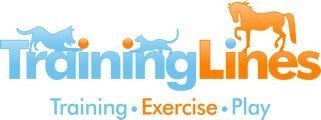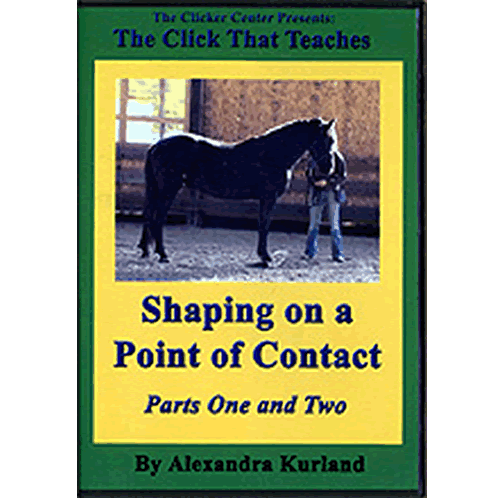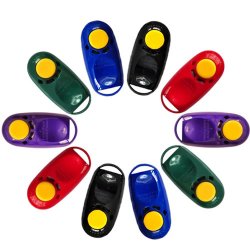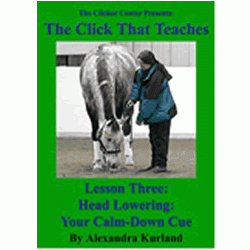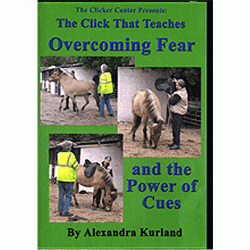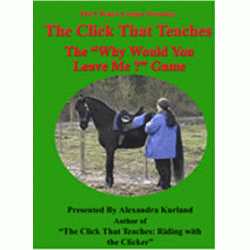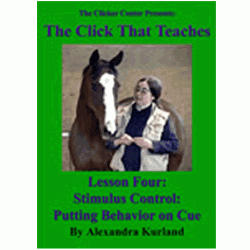DVD Lesson 6: Shaping On A Point Of Contact by Alexandra Kurland
How do you bring a horse into physical balance? By shaping on a point of contact so your horse becomes internally body aware and learns how to adjust his own balance. Find out what that means and learn the skills to help your own horse achieve physical and emotional balance.
Approx 2 hours.
-
Delivery info
We are delighted to ship our products within the UK, and throughout Europe and the rest of the world
-
Payment methods
Pay securely online through PayPal (a PayPal account is not required), or contact us.

-
Returns
We accept returns
On the surface "Shaping on a Point of Contact" is a lesson on standing on a mat - one of the foundation lessons. That's on the surface. What it is really about is learning how to work on a release to create the balance needed for upper-level performance.
The film features Keri Gorman and her three year old percheron cross, Oliver. Keri brought Oliver to the Oct. Toutle WA clinic. Oliver was originally a PMU foal. Keri got him when he was a year old. She's done a magnificent job with him. He's a good traveller. He's emotionally solid. He leads well. He's a very pleasant youngster, but . . . There's always a but. He was also three-year-old gangly. On Sat. Keri brought him into the arena to get him oriented to the new environment. She was going through the foundation exercises, including mat work. Oliver was great. He understood the mat, was willing to stand on it. But he was never square. Whenever he stopped, his legs were always sprawled every which way.
I've been wanting to get some good video of mat work for a video on mounting blocks, but I hadn't had the right horse for filming. What Oliver was doing was perfect for what I wanted. But we didn't have good light. So it was: Stop! Don't do any more. Let's wait until tomorrow when we have better light. We worked with Oliver just a few more minutes, then I did a long session with Keri going through the rope handling skills she'd need the next day in her session with Oliver. We uncovered some really important layers that needed to be shared. And of course - we weren't filming. Ah well.
That was Sat. On Sunday we brought out the camera and got some awesome footage. I started with two ground work sessions on rope handling skills, one with another clinic participant and the other with Keri. We covered the mechanics of the lead handling: how you shape on a point of contact - what that means and how you do it. We looked at core structure, finding your t'ai chi power so you can be powerful without being aggressive. We looked at the difference between gross and fine motor control, the effect each has on the feel down the lead and the ability to release the hand. Very interesting the difference there! We explored the effect of steady contact versus working on a release. That was fascinating and such a key concept. Between the two sessions we covered many core elements of good rope handling.
And then Keri worked Oliver. He started out a little nervous. He saw his first deer, and there were goats grazing in an adjoining field that he wasn't so sure about. His nervousness turned out to be a huge asset for the taping. Keri did a beautiful job handling him, illustrat well what going to a point of contact and waiting for a give means.
Oliver was also very wiggly. Anytime Keri touched the lead, he would curl around her in a lateral bend. "For every exercise you teach there is an opposite exercise you must teach to keep things in balance." For those of you with horses that are at this wiggly stage, this will be a very useful video. Keri found the tools she needed to balance the wiggliness. In the process Oliver shifted from being a gangly three year old to a "Fred Astaire" dance partner. Very, very neat!
We filmed him again the next day and the change in him was startling. He stood square - but not just, yeah he's got his front feet together square - he was lifting through his back and the base of his neck. He was gorgeous! I made some still photos from the video to compare his before and after balance. The change is startling.
So we got good video. But more than that, we covered some very important concepts. The real core of the lesson was this: when you sit on your horse, he will either protect his spine, or he will offer you his spine. You want him to offer you his spine because that's how you get enhanced movement.
What does this mean? One of the "t'ai chi" awareness exercises I shared with Keri and included on the video is a warm-up exercise for the head and neck. It's a simple exercise that I often use to help people understand - by feeling it for themselves - the changes we are asking the horse to give us in the initial stages of a lateral flexion. The concept is: when you break a movement down into its component parts, you change the nature of the movement. That's the whole essence of clicker training. We're splitters, not lumpers. This exercise let's you experience first hand what that means.
When I use this exercise in clinics I first have people glance behind them. I ask them to make note of what they see when they glance over their shoulder. Then we go through the lesson, breaking the movement down into three steps. When I have them glance over their shoulder at the end of the process, most people will report that they can see much further around.
All good. But I can increase the range of motion yet again by guiding the process with my hands. If I stand behind someone and place my fingers gently just behind her ears, I can guide the process. What emerges is not just a freer turn of the head, but a coming alive of the entire spine. You get a real "cat stretch" lifting through the shoulder blades (the withers), that comes up from the pelvis. The spine is coming alive with energy - exactly what we want our horse's spine to do when we ride.
Sometimes I will have the person stand behind me and feel these changes by resting a hand between my shoulder blades. Almost invariably the person will press too hard and I will feel my spine stiffen. I can't give them that lovely full "cat stretch" sensation, much as I want to. My spine is protecting itself. I can go through the outer trappings of the movement, but that really glorious feel of the "cat stretch" will elude them. But lighten the fingers, take the guardedness away, and it is there to be had.
This is such an important piece to understand for our horses. Are you getting the outer trappings of a movement, or the real thing where the horse lets you inside and offers you his spine? You can't demand this. The more you demand, the more he will protect himself. This is something he gives you because he trusts you enough to let you inside.
And that's what we got on video. It was one of those perfect sessions where Keri and Oliver were at the right stage in their work together to make this leap in connection. And what is even better - we got it on film!
This DVD is intended to accompany the book “The Click That Teaches: Riding with the Clicker”.
Approx 2 hours.
Click Here to read what Alexandra Kurland says about her series of clicker training books and DVDs, and how to get the best from the lesson sequence.
We are delighted to ship our products within the UK, and throughout Europe and the rest of the world, and we make it a priority to dispatch as quickly as we can. 98% of orders are on their way within 24 hours (Mon-Fri) and almost 100% within a couple of days.
Most UK orders are delivered by Royal Mail, Parcel Force, or Hermes, and once you have entered your address and postcode information (or signed in), you will be presented with one or more delivery options.
For international orders, we choose the most appropriate carrier depending on a number of factors. Not all of our products are suitable for international shipping, and size and weight restrictions may apply. If we are unable to send one or more of your order items, we are always happy to discuss alternative options with you.
Click below for more details:
Some products are marked as 'UK Delivery Only' or have similar restrictions. For delivery in another region, please contact us before ordering so that we can advise you on the options available.

Pay securely through PayPal. A PayPal account is not required.
Prefer to speak to a person? No Problem! Simply select 'Contact Us' at the checkout, and call us with your payment details after you submit your order.
If you would like to return your item(s) to us, you are welcome to do so and can post them to the address on the reverse of your Invoice/Delivery Note. Please retain proof of posting.
We ask that you let us know in advance if you can, and package them securely so that they arrive undamaged. Please also include a note that explains who you are, your order number, and how you would like us to handle your return (whether you would like a refund or an exchange, for example). A copy of your Invoice/Delivery note would be fine.
It would also help us to know why you are returning your item(s), but this is entirely optional.
There are exceptions. We cannot accept returns of 'Special Order' or bespoke items, for example (such as imprinted clickers), and some other restrictions do apply. Please see our full Terms and Conditions.
Not sure what to do? Please contact us.

